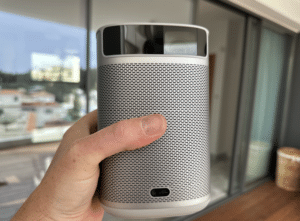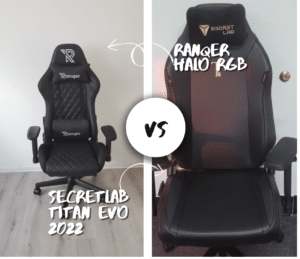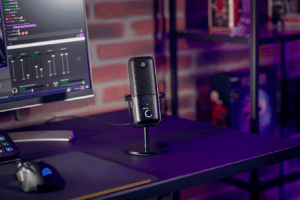Gaming projector 2023
Of course, games on the computer can also be experienced with great joy on a monitor. But playing on a gaming projector is much more fun. While a typical monitor is only around 22 to 34 inches in size, the projection surface on a projector for gaming can be an impressive 100 to 150 inches. Thereby are Immersion and gaming experience much more immersive and also the social factor plays into it as an advantage. When all friends are gathered around the screen and can cheer on you from any position in the room, the hours fly by and hours can turn into nights of gaming. That's reason enough for us to dedicate ourselves to the genre. We advise you on the purchase and present the most important criteria that are important for a gaming projector.
The best gaming projectors at a glance
| Preview | Products | ||
|---|---|---|---|

|
Acer Nitro G550 DLP... |
|
Buy now " |

|
BenQ DLP Full HD Gaming Projector... |
|
Buy now " |

|
Viewsonic X10-4K UHD Home Cinema... |
|
Buy now " |

|
BenQ TH671ST Full HD Projector... |
|
Buy now " |

|
XGIMI MOGO Pro, Mini Projector... |
|
Buy now " |

|
Viewsonic X10-4K UHD Home Cinema... |
|
Buy now " |

|
BenQ TK800M DLP Projector (4K... |
|
Buy now " |

|
XGIMI H2, 1080P Intelligent... |
|
Buy now " |
Home cinema and gaming - isn't that the same thing?
In principle, the "Home cinema projector" section also offers reliable information on the desired properties of the projector for the gaming PC, consoles such as the Xbox one, the PS4 and other multimedia devices. In particular, the high requirements in terms of image quality, resolution, brightness and contrast can also be used for the gaming projector. Nevertheless, the "Gaming Beamer" section is more specialized and precise.
In addition, another category is particularly important, namely the reaction times, in technical jargon as latency and Input Lag known. While in home cinema delayed image representations spoil the enjoyment of the film at best, the input lag decides between victory and defeat in a gaming projector. And nothing is more annoying than losing an exciting game just because the projector couldn't keep up with the fast image sequences, not to mention the lack of prospects of playing through a meaningful game to the end.
After all, by gaming projectors we mean projectors like this Acer Predator z650, which was deliberately designed for game mode, and home cinema projectors, which are wonderfully suitable as gaming projectors due to their properties. Reputable providers like Acer, BenQ, Epson and optoma carry good models that are well equipped for gaming and offer perfect immersion.
Latency times for the gaming projector
The latency describes the period of time between the executing impulse and the execution. It should therefore be as short as possible. Experts recommend an input lag of less than 50 ms as a guideline. Another key figure here is the frame rate, which describes how many images per second are projected onto the screen. The human eye is capable of perceiving 24 frames per second as a moving image (scene). Since the projection surface of projectors, sometimes well over 100 inches, is naturally larger than that of all other media formats, you will not get far with 24 Hertz (Hz) with a projector for gaming. Here, too, there are guidelines for orientation:
Video games can mostly be played at 60 Hz and above on the Xbox One and other devices. It should be at least 120 Hz on the projector, a frame rate of 240 Hz and 480 Hz is better and meets the highest demands for a fast, fluid display even with a lot of information without delays. A typical technique to improve frame rate and reduce latency is the interframe calculation, also interpolation. With this method, the values between the images are calculated and translated into movements. In this way, the successive frames in gaming can be doubled, quadrupled and even eightfold to the human eye. Technological progress is galloping in this area in particular.
The resolution
Crystal-clear images in Full HD or even 4K allow the player to delve deeper into the gameplay than coarse, dull and blurry-looking images can. In the field of home cinema, the Full HD format has replaced the once innovative HD standard as a mass standard for projectors too. This means that customers are already expecting Full HD resolution for home cinema and now perceive HD resolution as deficient. The resolution in 4K (Ultra HD), on the other hand, is (still) a luxury. Projectors that offer such a resolution come at a price, especially if this high value is based on a native resolution. Many providers, on the other hand, upscale the image until the resolution reaches 4K. However, this process results in a slight loss of quality in the games and films, so that a native 4K resolution is always the higher-quality variant compared to the 4K upscaling at a hunt.
There is also the problem that high resolutions in games are resource-intensive. This causes losses in the latency, so gamers should look for a good compromise between frame rate and image sharpness. The resolutions WXGA, WUXGA and QWUXGA correspond to the HD resolution (1280 × 720 pixels), Full HD resolution (1980 × 1280 px) and 4K image sharpness. The sharpness 4K (3840 × 2160 px) corresponds to four times the sharpness of the Full HD resolution (which in turn corresponds to four times the sharpness of the HD resolution) and is sometimes referred to as Ultra HD (UHD). The difference lies in the format, which at 16:10 isn't as wide as 16:9 and is closer to the earlier television standard of 4:3.
The contrast value
The contrast describes the difference in brightness between the darkest and brightest point of an image. The larger the value, the more accentuated and contoured the representations. High contrast values also stand for fine shades of gray and intense black tones. If the contrast value is too low, the image makes a dull and washed-out impression. Experts recommend a contrast ratio of at least 10.000:1 for multimedia content. Here in particular, customers have a lot of room for improvement, because projectors with contrast values in the millions are now being offered.
The contrast value
The brightness will be in ANSI Lumens measured, which at the same time showed the measure of the brightness. High values stand for a high brightness tolerance on the screen. This means that with a high number of ANSI lumens, the image can assert itself even more strongly against the ambient light. A projector with high values therefore projects images on the screen that are still clearly visible even in bright and even illuminated rooms. The level of ANSI lumens depends on the screen size. That's why information like this is more of a guide for home cinema or gaming projectors:
- 1.000 ANSI lumens: only suitable for dark rooms
- 2.000 ANSI lumens: also suitable for slightly lit rooms
- 3.000 ANSI lumens: suitable for daylight-bright living rooms
- 5.000 ANSI lumens: suitable for illuminated conference rooms
- 6.000 ANSI lumens: also suitable for outdoor demonstrations
It is therefore more accurate to use a counting method that refers to the size as a reference, such as to a square meter, which we will use in the following. Such a scale always allows the precise conversion to the respective size ratio of the projector. If we stay with the dependence of the brightness in ANSI lumens on the projection size of 1m², then the following values result:
- Less than 100 ANSI lumens: generally not suitable
- 100 to 250 ANSI lumens: suitable for dark rooms
- 250 to 500 ANSI lumens: also suitable for slightly lit rooms
- over 500 ANSI lumens: also suitable for bright rooms
The technology
The competing technologies are in projectors DLP (Digital Light Processing) and LCD (Liquid Crystal Display). In addition, more recently LED and Laser Added projector. Strictly speaking, LED lasers are not a new technology, but a familiar, particularly sustainable light source that has been improved in recent years to such an extent that it can generate enough brightness for the projector. The LED light of LED projectors can last up to 30.000 operating hours and thus for a lifetime. In comparison, a conventional UHP lamp gives up the ghost after just 3.000 hours of operation. With laser projectors, the light source lasts almost as long. The most impressive thing about them, however, are the razor-sharp and expressive images. Therefore, these are particularly suitable for home cinema and gaming, but unfortunately they are still high-end devices, even if they are becoming increasingly affordable. The projectors for the masses are still projectors based on DLP and LCD, whether with or without LED. We are particularly interested in the question of which of the two technologies is recommended for gaming.
With DLP technology, the image is generated by millions of small mirrors. Each mirror corresponds to a point of light. Rapid tilting movements, imperceptible to the human eye, create a rich reservoir of color gradations that are rendered visible on the canvas by a rotating color wheel. The advantages of this technology are the sharp contrasts, strong black tones, smooth movements, long service life and the fine mirror structure, which immunizes against the fly screen effect. On the other hand, the color fidelity is lower and the rotating color wheel, which can certainly cause an audible background noise, can cause light effects to appear on the screen on less powerful devices, which are known as rainbow effects.
With LCD technology, on the other hand, the white light is divided into the primary colors red, green and blue and recombined to form a uniform image. The liquid elements thus represent the image. The advantages of this technology are the natural, strong colors, the clear color gradients, the fine pixel delimitation and the color fidelity. In terms of resolution and image quality, you can also get more out of an LCD projector than a DLP projector. Many DLP projectors already reach their limits at 4K and are therefore more in the Full HD area. Also, not so many color nuances can be fully exploited, the color space is narrower. Most 4K projector are therefore based on LCD and laser technologies. What the rainbow effect is for DLP projectors, the fly screen effect is for LCD projectors, but the manufacturers of high-performance devices also have this problem largely under control.
After all, gaming projectors are offered in LCD and DLP, which is an indication that both technologies are in principle suitable for gamers. For example, many gamers would always choose an LCD projector because of the multifaceted colors and the high resolution. Nevertheless, many experts explicitly recommend a DLP projector for the gaming projector. They argue that this technology offers better response times. In addition, intensive players in particular benefit from the longevity of the wearing parts. But here, too, there is a counter-thesis to the thesis, because in terms of Speed LCD projectors score with smoother motion sequences.
Which connections are required?
In order to play complex games with high quality, digital connections such as HDMI and DisplayPorts are essential. However, technological advances have shifted priorities. While the question used to be whether it was analogue or digital or HDMI or VGA (with clinch), today the question with projectors for PS4 and Co. is in which generation the digital connection is available. The importance of this question is shown by the fact that only one HDMI2-Connect to play high-quality games in 4K HDR quality and at least 60 Hz. A 4K gaming projector therefore requires at least one interface for HDMI of the second generation. Sometimes the HDMI standard is used together with HDCP and ARC offered. HDCP is copy protection and ARC means that only one cable is required for the standard.
Gaming projector customers are usually multimedia enthusiasts and want a device with a large screen Flexibility. This allows them to use their device for games, films, music streaming, photos (slides) and much more. Helpful for establishing this flexibility is here AV Receiver, because it can be used to feed multiple multimedia devices via HDMI. Also, for an immersive multimedia experience, good sound is almost as important as a good picture. The transfer rate via HDMI2 is basically satisfactory. The external speakers also come standard with support for surround tones Dolby Atmos or DTS-HD for that certain something. Um too 3D movies to be able to enjoy or play 3D games on the gaming projector, the projector needs support for the 3D function. Shutter and polarization technology are available for 3D images. 3D projectors with polarization technology require a metallic screen, otherwise the light would be scattered. Shutter technology, on the other hand, is cheaper and suitable for laypeople.
What else needs to be considered when buying?
Of course, outstanding performance in the key metrics is attractive to gamers. Nevertheless, you should also consider the performance of your multimedia devices when purchasing one. For example, it is of little use if the gaming beamer is as fast as an arrow transmission speed of 480 Hz, but your own PC can only translate 60 Hz. Then it comes to this bottleneck effect, which gives away important resources and makes itself felt in your own budget.
In addition, not only the performance of the gaming projector and multimedia device contributes to the image quality, but also the Surface Fabric with its fabric structure specially optimized for projections, which intensifies the reflected light and makes colors look more natural. In order to be able to draw on the full here as well, we recommend a screen with a for gaming projectors luminance factor (Gain) from 1 to 1,5. With these values, the reflection behavior of the screen is perfectly tailored to the needs of gamers and this makes the colors appear haunting and intense, especially in the dark.
The type of games you prefer also make a difference in choosing the right device. It has already been mentioned that, especially with a limited budget, the performance of the projector for image quality and speed is always a compromise, because, for example, fantastically high-quality images devour a lot of resources that the speed can lack. Here it helps to look at your own preferences for the right gaming projector, because if you are more into games such as shooters that require a high reaction speed, it is best to opt for a fast-reacting projector with low latencies. If, on the other hand, the game atmosphere is more important to you, such as turn-based strategy or global strategy games in which the speed factor hardly plays a role, it is best to prioritize the image quality instead of the projector's reaction speed.
After all, the nature of your own premises also depends on the right gaming projector. A short-throw or even ultra-short-throw projector is very suitable for small rooms, as it only requires a short distance to the screen. If the rooms are cramped and there are a lot of things standing around, flexibility when setting up is very important. The remote focus and the Zoom. With a zoom factor of 2, it is already an extremely powerful device in the high-end sector. In addition, the lens shift and the keystone correction the trapezoid shift when the projector is moved. The lens shift is the higher-quality variant. It can implement the correction more directly and without sacrificing quality.











